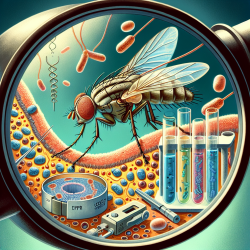The fascinating world of bacterial endosymbionts offers a wealth of insights into biological processes that are critical for both basic and applied sciences. One such endosymbiont, Wolbachia, is found in approximately half of all insect species and has become a model organism for studying infection dynamics. Recent research has provided new methodologies that practitioners can use to delve deeper into the mechanisms of Wolbachia colonization in Drosophila melanogaster.
The Importance of Accurate Quantification
A significant challenge in studying Wolbachia has been accurately quantifying its presence within host tissues. Traditional methods often fall short due to technical limitations. However, recent advancements have introduced optimized methodologies that allow for precise quantification through real-time qPCR and cytological techniques.
This research highlights the sensitivity of Wolbachia titers to dietary conditions, particularly yeast-rich diets. These diets significantly reduce ovarian Wolbachia titers without affecting the overall bodywide titer. This finding underscores the importance of absolute quantification methods over relative ones, which can be misleading due to changes in host DNA copy numbers under different conditions.
Practical Applications for Practitioners
- Nutritional Impact Studies: Practitioners can utilize these methodologies to explore how different nutritional regimes affect endosymbiont dynamics. Understanding these interactions can lead to better management practices in agricultural settings where Wolbachia is used to control pest populations.
- Cytological Techniques: The use of advanced imaging techniques allows practitioners to visualize and quantify Wolbachia in various developmental stages, providing insights into the timeline of bacterial colonization.
- Molecular Analysis: By employing real-time qPCR, practitioners can accurately measure bacterial loads across different tissues and developmental stages, facilitating more targeted research and interventions.
Encouraging Further Research
The methodologies presented in this study open new avenues for research into endosymbiotic relationships. Practitioners are encouraged to apply these techniques to investigate other host-endosymbiont systems or adapt them to study different cell and tissue types. Such research could lead to breakthroughs in our understanding of microbial ecology and its applications in biotechnology and medicine.
The study also emphasizes the need for rigorous statistical analysis and methodological validation, ensuring that findings are both reliable and reproducible. As practitioners adopt these advanced techniques, they contribute to a growing body of knowledge that bridges gaps between basic research and practical applications.










